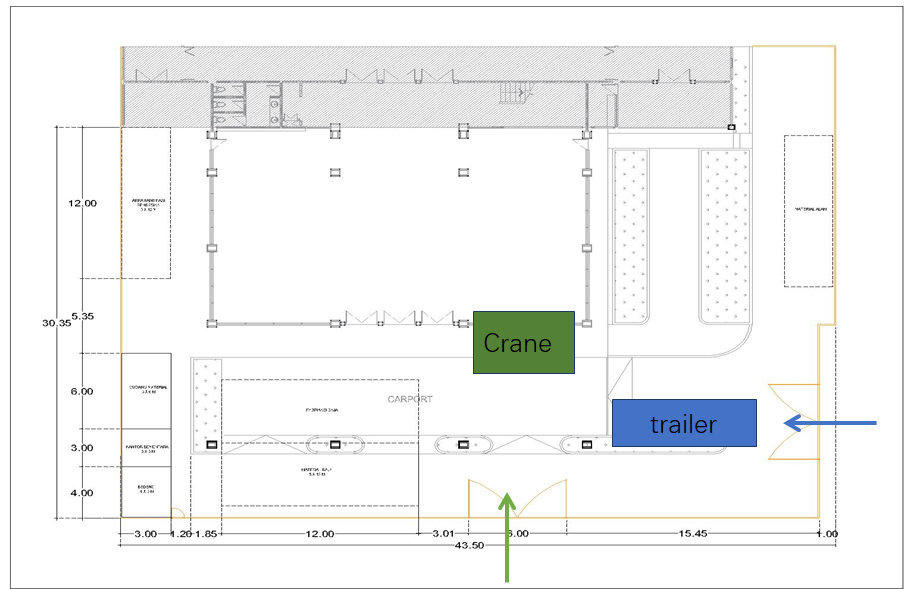
Published
Lessons Learned from Construction Site Layout Planning Practices
DOI:
https://doi.org/10.15446/ing.investig.107160Keywords:
construction site, empirical case study, Indonesia, project planning (en)sitio de construcción, estudio de caso empírico, Indonesia, planificación de proyectos (es)
Downloads
Proper layout planning is necessary to prepare a site for construction activities, prevent potential delays, and ensure project safety and security. Despite the considerable amount of studies regarding construction site layout planning, most research has relied on fabricated data using simulations, while, in fact, site layout is unique for each construction project, and its planning requires previous experience. This paper presents an in-depth study on site layout planning practices, as observed in four actual project cases. Using an empirical case study approach, these practices are collected through site observations, document examinations, and semi-structured interviews. Several discussions related to site layout planning practices are described, including the considerations, types, tasks and benefits related to proper site layout planning. The contribution of this paper is the ability to capture some lessons learned regarding construction site layout planning from actual project cases, which can be utilized by other parties for the benefit of future projects. The lessons learned allow developing appropriate strategies required by construction project teams in order to increase their response capability and hence be able to proactively make decisions regarding proper site layout planning.
La planificación adecuada de diseño es necesaria para preparar un sitio para actividades de construcción, prevenir posibles demoras y garantizar la seguridad de un proyecto. A pesar de la cantidad considerable de estudios sobre la planeación del diseño de sitios de construcción, la mayoría de las investigaciones se han basado en datos fabricados mediante simulaciones, si bien, de hecho, el diseño de sitio es único para cada proyecto de construcción y su planeación requiere experiencia previa. Este artículo presenta un estudio a profundidad sobre prácticas de planeación para el diseño de sitio en cuatro casos de proyectos reales, Empleando un enfoque de estudio de caso empírico, se recolectan estas prácticas por medio de observaciones en sitio, examen documental y entrevistas semiestructuradas. Se describen varias discusiones relacionadas con las prácticas de planeación para el diseño de sitio, incluyendo las consideraciones, los tipos, las tareas y los beneficios relacionados con una planeación adecuada para diseño de sitio. La contribución de este artículo radica en la posibilidad de capturar algunas lecciones aprendidas con respecto a la planeación del diseño de sitios de construcción de casos reales de proyectos, las cuales pueden ser aprovechadas por otras partes para el beneficio de proyectos futuros. Las lecciones aprendidas permiten desarrollar estrategias apropiadas según lo requieran los equipos de proyectos de construcción para aumentar su capacidad de respuesta y , por tanto, ser capaces de tomar decisiones de manera proactiva respecto a la planeación adecuada del diseño de sitio.
References
Abdel-Fattah, A. (2013). Dynamic site layout planning model [Doctoral thesis, University of Calgary]. https://prism.ucalgary.ca/bitstream/handle/11023/545/ucalgary_2013_abdel-fattah_aly.pdf?sequence=2&isAllowed=y
Adhika, H. D., and Nurcahyo, C. B. (2017). Optimasi site layout menggunakan multi-objectives function pada proyek pem-bangunan transmart rungkut surabaya. Jurnal Teknik ITS, 6(1), C22-C26. https://ejurnal.its.ac.id/index.php/teknik/article/viewFile/21535/3510 DOI: https://doi.org/10.12962/j23373539.v6i1.21535
Alanjari, P., Razavialavi, S., and AbouRizk, S. (2014). A simula-tion-based approach for material yard laydown planning. Au-tomation in Construction, 40, 1-8. https://doi.org/10.1016/j.autcon.2013.12.010
Alavi, S. R. R., and Rizk, S. A. (2017). Site layout and construction plan optimization using an integrated genetic algorithm simu-lation framework. Journal of Computing in Civil Engineering, 31(4), 04017011. https://doi.org/10.1061/(ASCE)CP.1943-5487.0000653
Alavi, S. R. R., and Rizk, S. A. (2021). Construction site layout planning using a simulation-based decision support tool. Lo-gistics, 5(65), 1-25. https://doi.org/10.3390/logistics5040065
Anbari, F., Carayannis, E., and Voetsch, R. (2008). Post-project reviews as a key project management competence. Tech-novation, 28(10), 633-643. https://doi.org/10.1016/j.technovation.2007.12.001
Andayesh, M., and Sadeghpour, F. (2013). Dynamic site layout planning through minimization of total potential energy. Au-tomation in Construction, 31, 92-102. https://doi.org/10.1016/j.autcon.2012.11.039
Baroncini, M., and Wong, C. (2022). Lessons learnt in construc-tion projects. Swiss Re Corporate Solutions Ltd. https://corporatesolutions.swissre.com/dam/jcr:f330d163-b624-4b29-9dbd-f7632be30dba/lessons-learnt-in-construction-projects.pdf
Binhomaid, O. S. (2019). Construction. [Doctoral thesis, Universi-ty of Waterloo] https://core.ac.uk/download/pdf/185636963.pdf
Caldas, C. H., Gibson, G. E., Weerasooriya, R., and Yohe, A. M. (2009). Identification of effective management practices and technologies for lessons learned programs in the con-struction industry. Journal of Construction Engineering and Management, 135(6), 531-539. https://doi.org/10.1061/(ASCE)CO.1943-7862.0000011
Cheng, M.Y., and O’Connor, J.T. (1996). ArcSite: Enhanced GIS for construction site layout. Journal of Construction Engineer-ing and Management, 122(4), 329-336. https://doi.org/10.1061/(ASCE)0733-9364(1996)122:4(329)
Costa, D. B., Formoso, C. T., Kagioglou, M., Alarcon, L. F., and Caldas, C. H. (2006). Benchmarking initiatives in the construc-tion industry: lessons learned and improvement opportunities. Journal of Management in Engineering, 22(4), 158-167. https://doi.org/10.1061/(ASCE)0742-597X(2006)22:4(158)
Dio, A. H., and Frenky, E. P. (2022). Evaluasi penataan pelaksa-naan pekerjaan pada sebuah site layout proyek konstruksi dari aspek waktu dan biaya dengan building information modeling 4d (studi kasus proyek X dan proyek Y) [Bachelor thesis, Universitas Katolik Soegijapranata]. http://repository.unika.ac.id/29392/1/21.B1.0060-Evi%20Parnius%20Frenky-COVER_a.pdf
El-Rayes, K., and Said, H. (2009). Dynamic site layout planning using approximate dynamic programming. Journal of Compu-ting in Civil Engineering, 23(2), 119-127. https://doi.org/10.1061/(ASCE)0887-3801(2009)23:2(119)
Fadhlan, D., Wiguna, I. P. A., and Rohman, M. A. (2020). Opti-masi penataan site layout pada proyek grand dharmahusada surabaya dengan metode logika fuzzy AHP. Jurnal Teknik ITS, 9(2), D250-D256. https://doi.org/10.12962/j23373539.v9i2.58373
Gordon, R. L, and Curlee, W. (2011). The virtual project man-agement office: Best practices, proven methods. Berrett-Koehler Publishers.
Hammad, A. W. A., Akbamezhad, A., Rey, D., and Waller, S. T. (2016). A computational method for estimating travel fre-quencies in site layout planning. Journal of Construction Engi-neering and Management, 142(5), 04015102. https://doi.org/10.1061/(ASCE)CO.1943-7862.0001086
Hansen, S. (2021). Characterizing interview-based studies in construction management research: Analysis of empirical lit-erature evidences. International Conference on Innovations in Social Sciences Education and Engineering (ICOISSEE), 1(1), 1-12. https://proceedings.conference.unpas.ac.id/index.php/icoissee/article/view/724
Hansen, S., Rostiyanti, S.F., and Rif’at, A. (2020). Causes, effects, and mitigations framework of contract change orders: Les-sons learned from GBK aquatic stadium project. Journal of Legal Affairs and Dispute Resolution in Engineering and Con-struction, 12(1), 05019008. https://doi.org/10.1061/(ASCE)LA.1943-4170.0000341
Hansen, S., Too, E., and Le, T. (2018). Lessons learned from a cancelled urban transport project in a developing country: The importance of the front-end planning phase. International Journal of Technology, 9(5), 898-909. https://doi.org/10.14716/ijtech.v9i5.1559
Harrison, W. (2003). A software engineering lessons learned repository [Conference presentation]. 27th Annual NASA Goddard/IEEE Software Engineering Workshop, Los Alamitos, California.
Hawarneh, A. A., Bendak, S., and Ghanim, F. (2021). Construc-tion site layout planning problem: Past, present and future. Expert Systems with Application, 168, 114247. https://doi.org/10.1016/j.eswa.2020.114247
Hegazy, T. M., and Elbeltagi, E. (1999). EvoSite: Evolution-based model for site layout planning. Journal of Computing in Civil Engineering, 13(3), 198-206. https://doi.org/10.1061/(ASCE)0887-3801(1999)13:3(198)
Hetemi, E., Gemunden, H. G., and Mere, J. O. (2020). Embed-dedness and actors’ behaviors in large-scale project life cy-cle: Lessons learned from a high-speed rail project in Spain. Journal of Management in Engineering, 36(6), 05020014. https://doi.org/10.1061/(ASCE)ME.1943-5479.0000849
Hu, Y., Chan, A. P. C., Le, Y., Jiang, W. P., Xie, L. L., and Hon, C. H. K. (2012). Improving megasite management performance through incentives: Lessons learned from the Shanghai Expo construction. Journal of Management in Engineering, 28(3), 330-337. https://doi.org/10.1061/(ASCE)ME.1943-5479.0000102
Jiang, W., Zhou, Y., Ding, L., Zhou, C., and Ning, X. (2020). UAV-based 3D reconstruction for hoist site mapping and layout planning in petrochemical construction. Automation in Con-struction, 113, 103137. https://doi.org/10.1016/j.autcon.2020.103137
Kamil, A. K. A., and Adnan, A. Z. A. (2020). Planning of con-struction site layout: A review. Journal of Science and Engi-neering Application, 4(1), 43-51. https://journals.iunajaf.edu.iq/index.php/JSEA/article/view/1
Khalafallah, A., and El-Rayes, K. (2006). Optimizing airport con-struction site layouts to minimize wildlife hazards. Journal of Management in Engineering, 22(4), 176-185. https://doi.org/10.1061/(ASCE)0742-597X(2006)22:4(176)
Kim, M., Ryu, H. G., and Kim, T. W. (2021). A typology model of temporary facility constraints for automated construction site layout planning. Applied Sciences, 11(3), 1027. https://doi.org/10.3390/app11031027
Kumar, S., and Bansal, V. K. (2015). Framework for safe site layout planning in hilly regions. European Journal of Advances in Engineering and Technology, 2(4), 14-19. https://ejaet.com/PDF/2-4/EJAET-2-4-14-19.pdf
Liang, C. J., Kamat, V. R., and Menassa, C. M. (2018). Real-time construction site layout and equipment monitoring [Confer-ence presentation]. Construction Research Congress, Reston, VA, USA. DOI: https://doi.org/10.1061/9780784481264.007
Ma, Z., Shen, Q., and Zhang, J. (2005). Application of 4D for dynamic site layout and management of construction pro-jects. Automation in Construction, 14(3), 369-381. https://doi.org/10.1016/j.autcon.2004.08.011
Marx, A., and Konig, M. (2011). Preparation of constraints for construction simulation [Conference presentation]. Interna-tional Workshop on Computing in Civil Engineering, Reston, VA, USA. DOI: https://doi.org/10.1061/41182(416)57
Mawdesley, M. J., Al-Jibouri, S. H., and Yang, H. (2002). Genetic algorithms for construction site layout in project planning. Journal of Construction Engineering and Management, 128(5), 418-426. https://doi.org/10.1061/(ASCE)0733-9364(2002)128:5(418)
Ning, X., Qi, J., and Wu, C. (2018). A quantitative safety risk assessment model for construction site layout planning. Safety Science, 104, 246-259. https://doi.org/10.1016/j.ssci.2018.01.016
Osman, H., Georgy, M., and Ibrahim, M. (2003). An automated system for dynamic construction site layout planning [Confer-ence presentation]. 10th International Colloquium in Structur-al and Geotechnical Engineering (ICSGE 2003), Cairo, Egypt.
Petroutsatou, K., Apostolidis, N., Zarkada, A., and Ntokou, A. (2021). Dynamic planning of construction site for linear pro-jects. Infrastructures, 6(21), 1-22. https://doi.org/10.3390/infrastructures6020021
Pheng, L. S., and Hui, M. S. (1999). The application of JIT philos-ophy to construction: A case study in site layout. Construction Management & Economics, 17(5), 657-668. https://doi.org/10.1080/014461999371268
Pradana, H. Y. (2021). Site layout optimization using multi-objectives function on dormitory building project (studi kasus: Proyek Pembangunan Gedung Asrama MTSN 1 Kebumen) [Bachelor thesis, Universitas Islam Indonesia]. https://dspace.uii.ac.id/handle/123456789/35883
Resende, C. B., Volk, M. J., and Shane, J. S. (2020). Post-project evaluation and lessons learned [Conference presentation]. Construction Research Congress 2020, Reston, VA, USA. https://ascelibrary.org/doi/10.1061/9780784482889.046
Rezania, D., and Lingham, T. (2009). Towards a method to dis-seminate knowledge from the post project review. Knowledge Management Research & Practice, 7(2), 172-177. https://link.springer.com/article/10.1057/kmrp.2009.9
Rowe, S. F, and Sikes, S. (2006). Lessons learned: Taking it to the next level [Conference presentation]. PMI Global Congress 2006, Seattle, Washington. https://www.pmi.org/learning/library/lessons-learned-next-level-communicating-7991
Sadeghpour, F., and Andayesh, M. (2015). The constructs of site layout modeling: An overview. Canadian Journal of Civil Engi-neering, 42(3), 199-212. https://doi.org/10.1139/cjce-2014-030
Sadeghpour, F., Moselhi, O., and Alkass, S. T. (2006). Computer-aided site layout planning. Journal of Construction Engineer-ing and Management, 132(2), 143-151. https://doi.org/10.1061/(ASCE)0733-9364(2006)132:2(143)
Said, H., and El-Rayes, K. A. (2011). Optimizing material pro-curement and storage on construction sites. Journal of Construction Engineering and Management, 137(6), 421-431. https://doi.org/10.1061/(ASCE)CO.1943-7862.0000307
Sanad, H. M., Ammar, M. A., and Ibrahim, M. E. (2008). Optimal construction site layout considering safety and environmental aspects. Journal of Construction Engineering and Manage-ment, 134(7), 536-544. https://doi.org/10.1061/(ASCE)0733-9364(2008)134:7(536)
Sezer, A. A., and Fredriksson, A. (2021). Environmental impact of construction transport and the effects of building certification schemes. Resources, Conservation and Recycling, 172, 105688. https://doi.org/10.1016/j.resconrec.2021.105688
Shiferaw, A. T., and Klakegg, O. J. (2013). Project evaluation: Accomplishments, shortfalls, and lessons learned in housing development projects in Ethiopia. Journal of Management in Engineering, 29(3), 289-301. https://doi.org/10.1061/(ASCE)ME.1943-5479.0000138
Sjøbakk, B., and Skjelstad, L. (2015). Proposing a standard tem-plate for construction site layout: A case study of a Norwe-gian contractor. In S. Umeda, M. Nakano, H. Mizuyama, N. Hibino, D. Kiritsis, and G. von Cieminski (Eds.), Advances in Production Management Systems: Innovative Production Management Towards Sustainable Growth (APMS 2015) (pp, 316-323). Springer. https://doi.org/10.1007/978-3-319-22756-6_39
Skejlbred, S., Fossheim, M. E., and Drevland, F. (2015, July 13-22). Comparing site organization and logistics in the construction industry and the oil industry: A case study [Conference presentation]. 23rd Annual Conference of the International Group for Lean Construction, Perth, Australia. https://iglc.net/Papers/Details/1178
Su, X. (2013). Spatial temporal information model for construc-tion planning [Doctoral thesis, Purdue University]. https://docs.lib.purdue.edu/dissertations/AAI3605150/
Su, X., Andoh, A.r., Cai, H., Pan, J., Kandil, A., and Said, H. M. (2012). GIS-based dynamic construction site material layout evaluation for building renovation projects. Automation in Construction, 27, 40-49. https://doi.org/10.1016/j.autcon.2012.04.007
Tam, C. M., and Tong, T. K. L. (2003). GA-ANN model for optimiz-ing the locations of tower crane and supply points for high-rise public housing construction. Construction Management and Economics, 21(3), 257-266. https://doi.org/10.1080/0144619032000049665
Tam, C. M., Tong, T. K. L., Leung, A. W. T., and Chiu, G. W. C. (2002). Site layout planning using nonstructural fuzzy decision support system. Journal of Construction Engineering and Management, 128(3), 220-231. https://doi.org/10.1061/(ASCE)0733-9364(2002)128:3(220)
Tsegay, F. G., Mwanaumo, E., and Mwiya, B. (2023a). Mathe-matical optimization methods for inner-city construction site layout planning: A systematic review. Asian Journal of Civil Engineering, 24, 3781-3795. https://doi.org/10.1007/s42107-023-00713-2
Tsegay, F. G., Mwanaumo, E., and Mwiya, B. (2023b). Construc-tion site layout planning practices in inner-city building pro-jects: Space requirement variables, classification and rela-tionship. Urban, Planning and Transport Research, 11(1), 2190793. https://doi.org/10.1080/21650020.2023.2190793
Vashishtha, A. U. (2022). A Framework to Optimize Construction Site Layout Planning. International Research Journal of Engi-neering and Technology, 9(3), 1911-1919. https://www.irjet.net/archives/V9/i3/IRJET-V9I3347.pdf
von Zedtwitz, M. (2003). Post-project reviews in R&D. Research-Technology Management, 46(5), 43-49.
Weber, R., Aha, D. W., Munoz-Avila, H., and Breslow, L. A. (2000). An intelligent lessons learned process. In Z. W. Raś and S. Ohsuga (Eds.) Foundations of Intelligent Systems (pp. 358–367). Springer. https://link.springer.com/chapter/10.1007/3-540-39963-1_38
Williams, T. (2007). Post-project reviews to gain effective lessons learned. PMI.
Xu, J., and Li, Z. (2012). Multi-objective dynamic construction site layout planning in fuzzy random environment. Automation in Construction, 27, 155-169. https://doi.org/10.1016/j.autcon.2012.05.017
Xu, S., Fu, D., Xie, Y., Hou, L., and Bu, S. (2020). Integrating BIM and VR for highway construction site layout planning [Conference presentation]. 20th COTA International Conference of Transportation Professional, Reston, VA, USA. https://doi.org/10.1061/9780784482933.093
Yin, R. K. (2003). Case study research: Design and methods (3rd ed.). Sage Publications.
Zhang, H., and Yu, L. (2021). Site layout planning for prefabri-cated components subject to dynamic and interactive con-straints. Automation in Construction, 126, 103693. https://doi.org/10.1016/j.autcon.2021.103693
Zhou, F. (2006). An integrated framework for tunnel shaft con-struction and site layout optimization [Master’s thesis, Universi-ty of Alberta]. https://era.library.ualberta.ca/items/ea82c2a6-b006-4618-b911-3a3c5587a541
Zolfagarian, S., and Irizarry, J. (2014). Current trends in construc-tion site layout planning [Conference presentation]. Con-struction Research Congress 2014, Reston, VA, USA. https://doi.org/10.1061/9780784413517.176
Zouein, P., Harmanani, H., and Hajar, A. (2002). genetic algo-rithm for solving site layout problem with unequal-size and constrained facilities. Journal of Computing in Civil Engineer-ing, 16(2), 143-151. https://doi.org/10.1061/(ASCE)0887-3801(2002)16:2(143)
Zouein, P., and Tommelein, I. (1999). Dynamic layout planning using a hybrid incremental solution method. Journal of Con-struction Engineering and Management, 125(6), 400-408. https://doi.org/10.1061/(ASCE)0733-9364(1999)125:6(400)
How to Cite
APA
ACM
ACS
ABNT
Chicago
Harvard
IEEE
MLA
Turabian
Vancouver
Download Citation
CrossRef Cited-by
1. Seng Hansen. (2025). Exploratory Factor Analysis of Construction Industry Problems in a Developing Country. Journal of Legal Affairs and Dispute Resolution in Engineering and Construction, 17(1) https://doi.org/10.1061/JLADAH.LADR-1205.
2. Hugo Sefrian Peinado, Luara Lopes de Araujo Fernandes. (2025). Integration of BIM and virtual reality in teaching construction site layout planning: an empirical study. Caderno Pedagógico, 22(8), p.e17232. https://doi.org/10.54033/cadpedv22n8-147.
3. Asmaa A. Soliman, Abdallah A. Mohammed, Ahmed H. Ibrahim. (2025). Dynamic construction site layout optimization using deep reinforcement learning with PPO. Engineering, Construction and Architectural Management, , p.1. https://doi.org/10.1108/ECAM-07-2025-1103.
Dimensions
PlumX
Article abstract page views
Downloads
License
Copyright (c) 2024 Seng Hansen

This work is licensed under a Creative Commons Attribution 4.0 International License.
The authors or holders of the copyright for each article hereby confer exclusive, limited and free authorization on the Universidad Nacional de Colombia's journal Ingeniería e Investigación concerning the aforementioned article which, once it has been evaluated and approved, will be submitted for publication, in line with the following items:
1. The version which has been corrected according to the evaluators' suggestions will be remitted and it will be made clear whether the aforementioned article is an unedited document regarding which the rights to be authorized are held and total responsibility will be assumed by the authors for the content of the work being submitted to Ingeniería e Investigación, the Universidad Nacional de Colombia and third-parties;
2. The authorization conferred on the journal will come into force from the date on which it is included in the respective volume and issue of Ingeniería e Investigación in the Open Journal Systems and on the journal's main page (https://revistas.unal.edu.co/index.php/ingeinv), as well as in different databases and indices in which the publication is indexed;
3. The authors authorize the Universidad Nacional de Colombia's journal Ingeniería e Investigación to publish the document in whatever required format (printed, digital, electronic or whatsoever known or yet to be discovered form) and authorize Ingeniería e Investigación to include the work in any indices and/or search engines deemed necessary for promoting its diffusion;
4. The authors accept that such authorization is given free of charge and they, therefore, waive any right to receive remuneration from the publication, distribution, public communication and any use whatsoever referred to in the terms of this authorization.


























